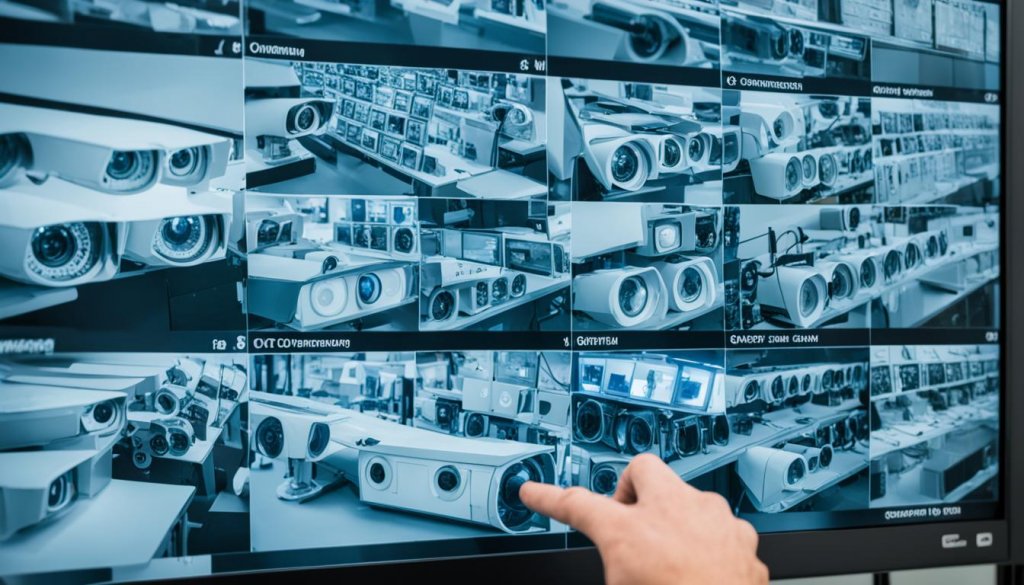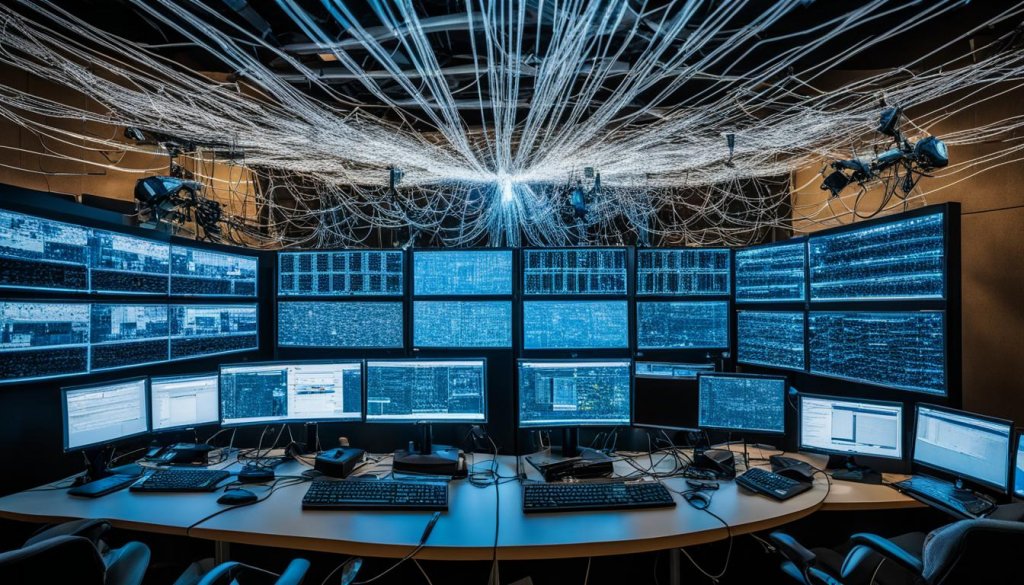Have you ever thought about how surveillance systems can stop crime and boost security? They don’t have to flood the operator with too many feeds. In my research on large-scale CCTV installations, I found that planning and managing them well is key to success. As businesses use commercial CCTV setups more, knowing how to plan CCTV systems is vital.
These systems do more than just watch; they help solve crimes and fill security gaps. Thanks to new tech, we have better ways to use these systems. But, it’s important to know how to put these technologies together for the best results. In this article, I’ll share the best ways to make surveillance systems work better and stronger. This will keep us up to date and ready.

Key Takeaways
- Understanding the importance of CCTV system planning can enhance surveillance efficiency.
- Advanced technologies play a pivotal role in optimizing CCTV management.
- Choosing the right equipment is critical for effective business surveillance solutions.
- Maintaining a robust system requires regular operation and maintenance checks.
- Awareness of cybersecurity risks can significantly improve the safety of CCTV systems.
- Strategically placing cameras can prevent common vulnerabilities and enhance safety.
Importance of Effective CCTV Management
Managing CCTV systems well is key to getting the most out of video surveillance. I’ve seen how a well-planned CCTV system can stop crime and keep an eye on things all the time. With the global video surveillance market set to hit $74.6 billion by 2025, it’s clear we’re counting on these systems more and more.
How well a system works depends on regular upkeep, cameras in the right spots, and being ready to fix problems. Remember, employee theft and fraud can cost businesses up to 7% of their annual income. Good management can help protect assets and boost security.
Banks and schools have seen big benefits from smart CCTV management. For banks, it helps control spaces and keep up with rules at branches and ATMs. In schools, it stops security issues and makes learning safer. It’s clear that managing CCTV systems well is very important.
Understanding Large-Scale CCTV Installations
Large-scale CCTV installations use advanced tech and many cameras for security. The type of camera used is key to the system’s success. IP cameras are often chosen because they work well with different systems, beating analog cameras in many cases.
For commercial CCTV setups, checking the recording systems is crucial. Network Video Recorders (NVRs) work great with IP cameras, offering top-notch performance. On the other hand, Digital Video Recorders (DVRs) are still common but can be less effective. Using high-resolution cameras like 1080p or 4k can make images much clearer. You’ll need high-definition monitors to fully enjoy these resolutions.
In smaller places, three to five monitors are enough to keep an eye on things. But in big areas like stores or warehouses, you might need more cameras to cover everything. These systems are useful in many places, like parking garages, restaurants, and for public safety.
Adding advanced analytics can make security even better. For example, Alarm.com CCTV systems offer tools like heat mapping and people counting. This helps gather detailed data. Knowing how large-scale CCTV systems work and their uses ensures they all work together for better security.
CCTV System Planning Essentials
Planning a CCTV system starts with a deep look at our security needs. I first figure out what our security goals are. This includes thinking about the threats we might face and where they could happen. It’s key to spot security weak spots early to make sure our CCTV covers the right areas.
Assessing Security Needs
To assess security needs, I talk to different people. I get input from management, staff, and security teams about their views on risks. This teamwork helps make sure the CCTV system watches over what’s most important to everyone.
Identifying Vulnerabilities and Key Access Points
By looking closely at our space and how it works, I find spots where security could be weak. I spot areas that need extra watch, like blind spots and high-risk areas. Knowing these spots helps me pick the right cameras and where to put them, making the system more reliable.
Choosing the Right Equipment
Choosing the right CCTV equipment is key for top-notch security on big projects. It’s important to know the different types of cameras out there. By looking at each option—like dome, bullet, or PTZ cameras—I can pick the best one for the job. Some cameras work great in small spots, while others are perfect for high-security zones.
Each camera type has its own set of features designed for specific surveillance needs. This makes it vital to carefully pick the right one for the task at hand.
Evaluating Camera Types and Features
When checking out CCTV cameras, some features stand out as must-haves. I always look for Internet Protocol (IP) compatibility and high-definition resolution. Being able to connect cameras with other security systems is also key for a complete security setup.
Choosing the right cameras, like License Plate Recognition (LPR) or Multi-Sensor models, depends on knowing where they’ll be used. Each feature is crucial for making sure surveillance works well and fits the space.
Balancing Cost and Performance
Figuring out the balance between cost and performance is a big part of my decision-making. I compare the long-term benefits of high-quality cameras with their upfront cost. Options like networked cameras with Power-over-Ethernet (PoE) technology are great for saving money without losing quality.
Looking into storage options, like cloud or local hard drives, helps me plan for costs and find the best setup. By focusing on these factors, I can boost security and make the most of my budget in large-scale projects.

Professional Security Camera Installation
For any organization that values safety, professional security camera installation is key. The right setup boosts your surveillance system’s performance. Certified CCTV installers bring the expertise needed to tailor the system to your security needs.
Working with Certified Installers
Certified CCTV installers are crucial for a strong security setup. They have experience in many fields, from factories to schools and apartments. Their advice on choosing the right cameras and features is essential. They recommend advanced cameras like infrared and PTZ cameras to improve security.
The Impact of Proper Wiring and Infrastructure
Good wiring is crucial for CCTV systems. Bad wiring can cause signal loss or poor coverage. A well-planned wiring setup ensures all parts work well, which is key for reliable data.
High-resolution cameras and big storage NVRs are important for detailed footage. But, they need strong wiring to work right.
Optimizing CCTV Camera Placement
Getting the most out of surveillance depends on placing CCTV cameras right. By covering key areas well, we can catch more and stop potential trouble. I make sure to watch all entry points and busy spots closely. This helps spot suspicious actions fast.
Strategically Covering Key Areas
I start by focusing on spots like front and back doors, garage doors, driveways, and windows. These spots are key because they’re often where people come in. I check for things that might block the view, like trees or walls, to make sure nothing is missed.
Addressing Blind Spots and Coverage Gaps
Finding and fixing blind spots is key to good CCTV placement. Deciding between wide or narrow camera views affects how we place them. Wide views cover a lot but might miss details. Narrow views are better for seeing things up close, like faces or plates.
Good lighting is also important for clear footage. I avoid putting cameras where bright lights might wash out the view. Using the latest camera tech helps make my security even stronger.
Advanced Security Camera Systems
In today’s world, advanced security camera systems are key for good surveillance. They use the latest technology to make CCTV better. With cloud video solutions and AI in CCTV, managing security is now easier than ever.
Incorporating Cloud-Based Solutions
Cloud video solutions give me easy access to recordings and work well with many security features. This is great for big installations where managing data gets hard. Storing footage in the cloud lets me check and analyze videos from anywhere, making security responses better.
Cloud solutions also make storage easy and allow for real-time monitoring. This means I can take action quickly to prevent risks.
Utilizing AI and Intelligent Monitoring
AI in CCTV brings smart monitoring that automatically checks footage for threats. This cuts down on false alarms and focuses on important incidents. With AI, my surveillance systems don’t just watch; they act ahead to stop threats.
Systems with AI are great for places like schools and shops, making everyone safer and more secure.
Cybersecurity Considerations for CCTV Systems
CCTV systems are becoming more common worldwide. This means we need strong cybersecurity for them. It’s crucial to keep these systems safe from hackers and other threats. By taking the right steps, we can protect these important tools.
Securing Cameras Against Unauthorized Access
Strong passwords are key to keeping CCTV systems safe. We should change default usernames and passwords to reduce risks. Using end-to-end encryption is also vital. It keeps data safe from hackers and ensures video feeds are real.
Big names like Panasonic and Axis offer top-notch encryption. This makes CCTV systems much safer.
Regular Software Updates and Patch Management
Keeping CCTV software up-to-date is crucial for security. Regular updates help fight off cyber threats. Experts recommend setting up service agreements with vendors for easy updates and maintenance.
This approach helps avoid problems caused by old software. Focusing on cybersecurity is key for CCTV systems in important areas like healthcare and traffic monitoring.

Operation and Maintenance Best Practices
Keeping a CCTV system in top shape is key to its success. A maintenance plan that fits the system’s needs is vital. Regular checks spot problems early and keep everything running well.
Establishing a Maintenance Schedule
Setting up a regular maintenance plan is crucial for CCTV systems. Checking cameras, power units, and digital parts helps keep them working right. Doing full system checks every three months stops small issues from getting bigger.
I suggest checking the date and time settings, looking at recorded footage, and making sure cameras are aimed right every week. This keeps the equipment lasting longer.
Using Intelligent Monitoring Software
Intelligent monitoring systems make maintenance easier by doing checks automatically and alerting you to problems. They can find issues fast, like a camera that’s not working or sending strange data. This helps fix things quickly.
Using this software makes my CCTV system more reliable and efficient. It also helps me decide when to upgrade or replace equipment, keeping my security up to date.
Overcoming Post-Installation Challenges
After installing a CCTV system, I often run into challenges that affect its performance. These include physical limits and the demands of CCTV operations. It’s important to tackle these issues quickly to keep the system reliable and effective.
Physical Limitations and Infrastructure Concerns
One big challenge is dealing with physical barriers like distance to power sources or limited infrastructure. Overcoming these limits is key to providing enough power and connectivity to all cameras. I focus on building strong infrastructure, like using solid copper CAT6 cables, to extend the reach of my setup.
Using PoE extenders helps me cover large or complex areas efficiently. This way, I can ensure all areas are well-covered.
Managing Operational Demands
CCTV systems need constant monitoring and upkeep. Big installations produce a lot of data, so managing it well is crucial. I must balance privacy concerns with legal requirements.
Keeping an eye on camera performance is vital since the environment can impact how well they work. A good maintenance plan helps keep the equipment running smoothly and extends its life.
Integrating CCTV into Comprehensive Security Solutions
When I think about making my property safer, I know it’s key to link CCTV with other security steps. This mix turns basic surveillance into a strong defense against many security issues. By combining CCTV with access control, I get a single system that makes monitoring easier and quickens response times. This approach helps create a full security circle.
Pairing with Access Control Systems
Linking access control with CCTV boosts my ability to check who’s coming in or going out. These technologies work together to make it easier to spot people moving in and out. This combo keeps detailed records, which is great for following rules, and strengthens security. It’s vital for places that get a lot of visitors or are very private.
Creating a Holistic Security Environment
When I use systems that work well together, I get a full security setup. Modern tech in my CCTV gives me live updates and alerts. Managing security from one place makes it simpler to watch over different spots from afar. This integration boosts efficiency and makes my security plan more effective. With careful planning, CCTV and access control can make a safer place.
Monitoring and Evaluating CCTV Effectiveness
To keep my CCTV systems working well, I check the footage often. This helps me see how well the CCTV works. By looking at the recordings, I spot patterns and areas that need better security.
This keeps me ready for new threats and makes sure my security stays up to date.
Regularly Reviewing Recorded Footage
Looking at the footage helps me see how my cameras are doing and their effect on security. Studies show that checking the footage often can lead to useful changes. It shows CCTV’s role in stopping crime.
It’s especially useful in places like parking lots where it can really make a difference. So, I make it a habit to check the footage regularly.
Gathering Data for Continuous Improvement
Collecting data from checking the footage helps me improve security over time. I use what I learn to decide on updates or changes. Research says using CCTV with other security steps makes it even better.
This way, I can tackle new security issues and get the most out of my CCTV.
Regulatory Compliance and Adherence
It’s crucial to follow CCTV rules for any security system. This ensures my surveillance meets legal standards. Knowing the laws helps me set up a legal surveillance area. Without understanding these rules, I could face big legal problems.
Understanding Local, State, and Federal Laws
Knowing the laws about CCTV helps my system meet legal needs. I must know which cameras are allowed under the National Defense Authorization Act (NDAA). Brands like Huawei, Hikvision, and Dahua are banned because they’re a security risk.
Using NDAA-compliant cameras means I get better security features. These include strong encryption and secure data sending. This makes my system more secure and follows the law.
Documenting Compliance for Audits
Keeping detailed records is key for audits and showing I’m open. These records include info on camera makers and NDAA rules. They also show I’m up to date with compliance.
Companies like Mammoth Security offer great advice on NDAA-compliant systems. This builds trust in my surveillance setup.
Conclusion
Managing large CCTV installations requires careful planning and action. From what I’ve learned, it’s key to follow best practices for CCTV management. This means picking the right tech and making sure it meets legal standards.
By using advanced tech and following the rules, I can make any place much safer. This approach helps me keep up with security needs and new threats.
We’ve looked at many CCTV management topics, like the need for upkeep and cybersecurity. By keeping these tips in mind, I can make my surveillance systems better. It’s important to always check and change my methods to stay effective in protecting my business or community.
In short, the way to strong security with CCTV is clear. By choosing the right systems and sticking to strict rules, I can be sure I’m doing everything I can for safety. Moving to better surveillance solutions can really change things, giving me peace of mind and active security management.
See how FieldAx can transform your Field Operations.
Try it today! Book Demo
You are one click away from your customized FieldAx Demo!
FAQ
What are the benefits of large-scale CCTV installations?
Large-scale CCTV installations are key to protecting properties and keeping public areas safe. They provide crucial evidence for investigations. They act as a strong warning to criminals and keep important areas under watch.
How important is effective planning in CCTV system management?
Planning is crucial for making CCTV systems fit specific security needs. By looking at weak spots and key entry points, I can make sure surveillance is thorough and focused. This makes the system work better.
What should I consider when choosing CCTV equipment?
When picking CCTV gear, it’s key to look at different camera types like dome, bullet, or PTZ. Think about their features and what they’re meant for. It’s also important to balance cost with how well it works to get good value over time.
Why is professional installation important for CCTV systems?
Getting certified pros to install CCTV systems is key for the best performance. They know how to set up all parts right, making sure the system works reliably.
How can I optimize camera placement for better surveillance?
To get the most out of CCTV cameras, place them in strategic spots like where people come and go. Make sure to cover blind spots to improve surveillance. This makes motion detection more accurate.
What advanced technologies can enhance my CCTV system?
Adding cloud-based and AI-driven tech to CCTV systems boosts their power. These new features make accessing and managing data easier and help in making smarter decisions.
What cybersecurity measures should I implement for my CCTV systems?
To keep CCTV systems safe, use strong passwords, encryption, and update software regularly. These steps protect footage and reduce risks from cyber threats.
How can I ensure the longevity of my CCTV system?
Keeping up with regular maintenance is key. Check for any issues early to keep security strong. Using smart monitoring tools helps spot and fix problems fast.
What challenges might I face post-installation?
After installing CCTV, you might face issues like distance to power or managing its needs. It’s important to tackle these problems early to keep the system working well and secure.
How can I integrate CCTV with other security solutions?
Linking CCTV with other security tools like access control makes a stronger security setup. This integration boosts overall effectiveness and makes managing security incidents easier.
Why is monitoring recorded footage important?
Checking recorded footage often is key to seeing how CCTV works. Looking at past data helps spot trends and improve security steps over time.
What regulatory compliance should I be aware of for CCTV systems?
Following local and national laws for CCTV is a must. Knowing these rules helps make sure your surveillance is legal and avoids legal trouble.
Author Bio
Co-Founder & CMO at Merfantz Technologies Pvt Ltd | Marketing Manager for FieldAx Field Service Software | Salesforce All-Star Ranger and Community Contributor | Salesforce Content Creation for Knowledge Sharing






